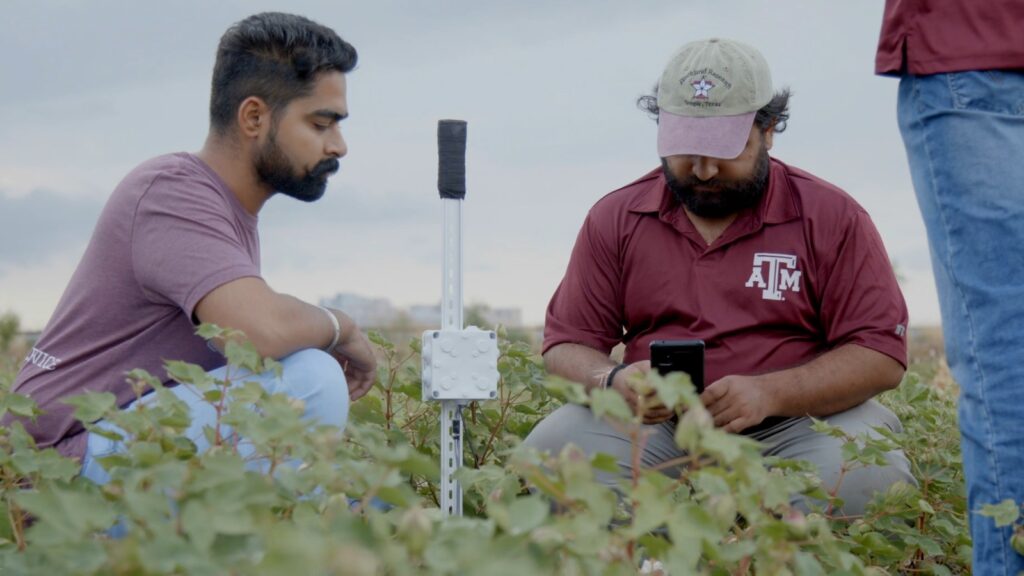Texas A&M AgriLife Research, IBM streamline ‘when to water’ app and sensors for producers
Liquid Prep app aims to provide accurate data, global cost-effectiveness
Texas A&M AgriLife Research and IBM are working to develop low-cost sensors and a smartphone app, aimed to provide farmers a new tool for making real-time decisions about when to water crops.

The IBM-developed app, Liquid Prep, relies in part on probe sensors to detect soil moisture levels and collect data. Streamlining of the technology now lies partially in the hands of researchers at the Texas A&M AgriLife Blackland Research and Extension Center at Temple.
The researchers are testing to validate the efficacy of the IBM-developed sensors. Eventually, they will recruit Texas farmers to test the technology in real-world environments.
The effort to develop Liquid Prep is part of the IBM Sustainability Accelerator program. This global, pro-bono social impact program leverages the company’s technology and expertise against environmental challenges like climate change, extreme weather and pollution, IBM researchers said.
The Liquid Prep app will be built to combine weather data from IBM, crop-specific information from the AgriLife Research scientists at Temple and real-time soil moisture data from the new sensors. The app will use the combined data to provide farmers with insights to help decide when and how much to water crops, accounting for a range of specific crops.
“The goal for these sensors is that one day they will serve as the most cost-effective solution for irrigation recommendations available to producers in Texas and, eventually, across the globe,” said Raghavan Srinivasan, Ph.D., director of the Texas A&M AgriLife center at Temple. Srinivasan is also a professor and Regents Fellow in the Department of Ecology and Conservation Biology and the director for the Spatial Science Laboratory in the Department of Biological and Agricultural Engineering.
“Texas A&M AgriLife’s technical expertise and extensive network in the agriculture industry has led to many technology innovations and opportunities to impact agricultural communities,” said Michael Jacobs, IBM sustainability and social innovation leader. “The collaboration between this team and IBM data science and machine-learning experts aims to help make key data useful for smallholder farmers.”
Integrating data technologies for machine learning
The researchers are strengthening Liquid Prep by integrating Texas A&M AgriLife’s Soil and Water Assessment Tool, SWAT, and IBM Environmental Intelligence Suite, EIS, Geospatial Analytics. Their goal is to combine these data systems to simplify development and deployment of machine-learning models for sustainable agriculture.
SWAT provides high-resolution, field-scale forecasts and analysis of soil, water and agriculture metrics. IBM EIS Geospatial Analytics provides satellite data and weather information. Machine-learning models will process their combined data into decision-making insights for farmers.
SWAT-EIS integration would help provide insights on three drought types: meteorological, agricultural and hydrological. A system for understanding the varied attributes of all three types would provide a more complete understanding of drought effects on crops — a boost to stronger agricultural productivity and water management.
Validating and improving sensor performance
The process of realizing a global cost-effective tool is in the early stages, said Gurjinder Baath, Ph.D., assistant professor in the Texas A&M Department of Soil and Crop Sciences and leader of the sensor validation process in Temple.
The first step toward adoption of Liquid Prep is to ensure that the technology is sound and accurate, Baath said. His team’s work involves collecting data from the new sensors and parsing it against results from more involved laboratory testing of soil samples. The team also tests the IBM sensor results against those produced by other proprietary sensors utilized for research at the Texas A&M AgriLife center at Temple.
“Overall, we’re looking for reliability of results, cost-effectiveness and simplicity of use,” Baath said, pointing out that early results are promising. The teams’ work involves identifying technical issues in the new platform and retesting streamlined iterations from IBM.
Baath said additional validation work on the new sensors is being undertaken collaboratively at private farms in Alabama, Louisiana, Texas and Ottawa, Ontario, including testing soils in compositional contrast to the black clay soils of Temple. This is to test the sensors’ viability in varying conditions and different crops including corn, wheat and soybeans.
Next steps in sensor validation
While development of Liquid Prep technology remains in the early stages, Srinivasan said, the AgriLife Research team’s work has opened the doors to global conversations about possibilities for emerging technologies as well as existing ones developed at the Texas A&M AgriLife center at Temple.
Since the late 1970’s, the center has developed computer models and big-data systems for understanding and predicting a range of processes related to farm and rangeland management.
“We have received many inquiries, especially lately, based on the information IBM has put out so far on our work together with Liquid Prep,” Srinivasan said. He emphasized possible progress toward making Liquid Prep economically viable for farmers in developing countries.
Talks that began with work on Liquid Prep technology, Srinivasan said, have also blossomed to include more comprehensive possibilities for AgriLife Research’s computer modeling and decision-support systems at the center in Temple. Applications for the technology include more general climate protection as well as possible collaborations across several countries outside the U.S. including Ukraine.
In the immediate future, Baath and Srinivasan look forward to recording the results of their Liquid Prep sensor validation work for peer-reviewed publication in scientific journals.


